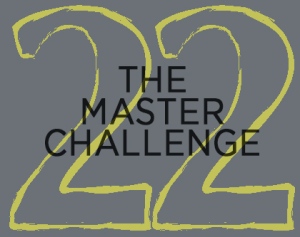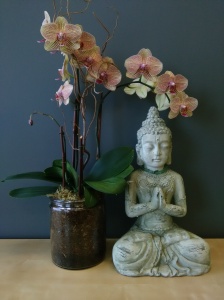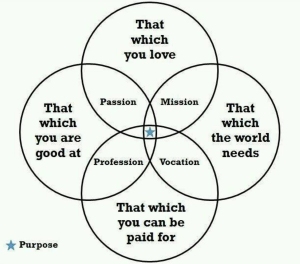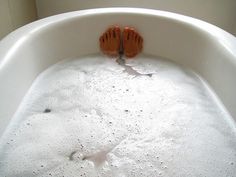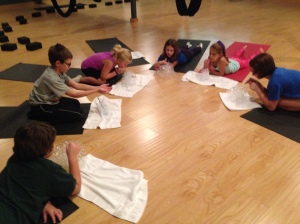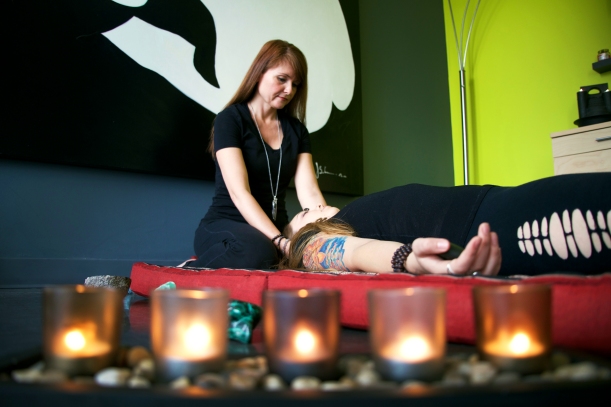 Also called Thai Massage, Thai Bodywork is a combination of massage, Acupressure, energy meridian work and Yoga-like stretching.
Also called Thai Massage, Thai Bodywork is a combination of massage, Acupressure, energy meridian work and Yoga-like stretching.
Most people are familiar with “massage,” which involves working on the body’s musculature with compression and manual manipulation. In the United States, massage is typically performed on a specialized table with techniques strongly influenced by Swedish massage, which became popular in the mid 1900’s via physicians in New York who practiced in the Swedish tradition, which includes rubbing and moving muscles with an ultimate goal of relaxation.
Thai Bodywork, by contrast, is deep, full-body work, incorporating Ayurvedic Principles. By relieving muscular tension, improving circulation, boosting the immune system and replenishing the body’s energy, the recipient leaves the session feeling physically and energetically blissful.
Thai Bodywork can be performed on a massage table or chair, but it is traditionally and most effectively performed on the floor, with the recipient lying on a comfortable mat and the practitioner kneeling or standing over her. This allows the practitioner to use body mechanics and gravity to her advantage, promoting the longevity of her ability to perform massage, as well as allowing the use of elbows, knees and feet to apply deeper pressure when appropriate.
Progressing from the feet up, energy pathways are cleared, muscles are elongated, joints are mobilized, internal organs and all bodily functions are supported to move the client towards a more balanced state. While techniques of soothing muscle manipulation are used, the focus is on the health of the body rather than on relaxation.
History
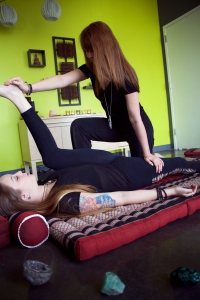 Touch is a vital part of healing, physical, mental and emotional, and healing touch has been in practice for centuries, perhaps since the dawning of mankind.
Touch is a vital part of healing, physical, mental and emotional, and healing touch has been in practice for centuries, perhaps since the dawning of mankind.
There is evidence of massage as an important practice in ancient Eqypt, as documented on tomb walls dated to 2500 BCE. We have detailed information of the practice as an important part of Traditional Chinese Medicine from the 8th Century BCE, and we know that Thai Massage was codified as a healing system by 500 BCE. Its practice is well documented by Ancient Greek scholars and in Biblical passages, as well as in the earliest extant Ayurvedic writings from India, circa 400 BCE. Trade routes between Egypt, Greece, China, and India have been in place since at least 2000 BCE, and it is likely that in addition to goods, knowledge and services were shared among the cultures. Most scholars agree that Thai massage is strongly influenced by Ayurvedic massage from India as well as by methods of acupuncture and reflexology from China.
What is Ayurveda?
Ayurveda, which literally translates as the “science of life,” is a holistic medical science that has been practiced in India for at least 5,000 years. Recognizing that human beings are part of nature, Ayurveda describes three fundamental energies that govern our inner and outer environments: movement, transformation, and structure. Known in Sanskrit as vata (air), pitta (fire), and kapha (earth), these primary forces, or doshas, are responsible for the characteristics of our mind and body. Each of us has a unique proportion of these three forces that shapes our nature. If vata is the primary dosha in our system, we tend to be thin, light, enthusiastic, energetic, and changeable. If pitta predominates in our nature, we tend to be intense, intelligent, athletic and goal-oriented, with a strong appetite for life. When kapha prevails, we tend to be easy-going, loyal, sturdy and nurturing. Although each of us has all three forces, most people have one or two elements that predominate.
For each element, there is a balanced and imbalance expression. When vata is balanced, a person is lively and creative, but when there is too much movement in the system, a person tends to experience anxiety, insomnia, dry skin, constipation, and difficulty focusing. When pitta is functioning in a balanced manner, a person is warm, friendly, disciplined, a good leader, and a good speaker. When pitta is out of balance, a person tends to be compulsive and irritable and may suffer from indigestion or an inflammation. When kapha is balanced, a person is sweet, supportive, and stable but when kapha is out of balance, a person may experience sluggishness, excess weight gain, and sinus congestion.
Ayurveda held a prominent place in the Buddha’s life during the 4th century BCE in India as he was attended by his personal Ayurvedic doctor, Javaka Kumar Bhaccha. Although Buddhism is not widely practiced in India today, the Buddhist faith quickly spread east across Asia. Buddhism was widely accepted in Southeast Asia, and today, Thai people are predominantly Buddhist. In fact, Dr. Javaka (or Shivago) is celebrated in Thailand as the honored guru of Thai Massage, and his belief in Loving Kindness is still invoked daily.
Unlike Ayurvedic Massage, no oil is applied during Traditional Thai Massage. At Zen Body, however, essential oils may be applied depending on the client’s Ayurvedic constitution and any imbalances that may be present. Similarly, the practitioner’s touch, pace and sequencing will be directly suited to the client’s individual needs and imbalances.
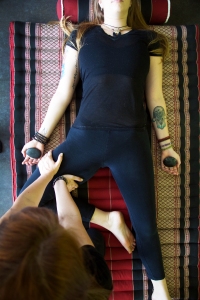 “A Lazy Man’s Yoga”
“A Lazy Man’s Yoga”
Yoga and Ayurveda are “sister sciences,” both codified in India with the goal of promoting health. In general, Ayurveda focuses on physical health and Yoga focuses on holistic mental health. In regard to Thai Bodywork, the Yoga influence is seen in the stretching postures, which are a small part of the tradition of Yoga, but the best-known aspect of Yoga today, particularly in the West.
In Thai Bodywork, the recipient remains fully clothed and is positioned on a floor mat. This enables the practitioner to move, stretch and bend the recipient into a variety of Yoga-inspired postures. In fact, this modality is often referred to as Thai Yoga Massage or Thai Yoga Therapy, and has been called the “lazy man’s Yoga,” although it most certainly is much more than that.
While similar to a Yoga practice in that the body is used as a gateway to access something deeper, in Thai Massage, there is no physical effort or strain, and it is often possible to achieve a deeper range of motion as the assisted stretching allows the recipient to completely relax, helping to establish greater flexibility by promoting length in muscle fibers and connective tissue.
Joint mobility, muscular flexibility, myofascial release and increased blood and lymph flow are just some of the benefits of this portion of Thai Bodywork.
Acupressure and Meridian Energy Work
Acupressure is an important part of Thai Bodywork, with principles influenced by both Traditional Chinese Medicine and the Ayurvedic Tradition of Ancient India. This pressure applied on particular points which lie along the body’s energy lines is believed to restore the energy balance throughout the body.
The energy itself is called chi or qi in China, ki in Japan, prana in India and lom in Thailand. The energy is absorbed from the air we breathe and the food we eat, and moves through us along lines called meridians or channels in China, nadis in India and sen in Thailand. All of these lines, whether meridians, nadis or sen, contain numerous points where small energy centers exist in correlation with various parts of the body. These points are found where two or more types of tissue meet, such as muscles, veins, ligaments, bones or joints, and they include the major and minor chakras of the Indian system. Each tradition believes that blocked energy is the cause of disease and that massage helps keep the vital forces moving.
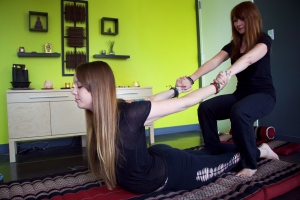 Thai Bodywork at Zen Body
Thai Bodywork at Zen Body
The feet are the first, and some say most important, parts of the body to be worked during Thai Bodywork. There are a large number of nerve endings make the feet very responsive to touch. This, along with the many reflex points associated with every part of the body, make foot work a focus of massage in cultures around the world, and Thai Massage is no exception. Zen Body’s Thai Reflexology stimulates energy channels by massaging the feet to promote balance and harmony, physically, mentally and emotionally. Organic coconut oil or almond oil as well as other essential oils may be applied depending on the client’s Ayurvedic constitution and any imbalances that may be present. Aromatic hot towels complete this very powerful and extremely pleasurable treat for tired and aching feet.
Following the foot massage, the practitioner uses her hands, forearms, elbows, knees and feet to work the entire body with compression, kneeding, and acupressure, stimulating and balancing the flow of the body’s own healing energy, releasing blockages and bringing the recipient deeper into balance and harmony. All the while, relaxing assisted stretches improve flexibility and range of motion, tense muscles are soothed, and specific trouble areas or physical limitations are treated as needed.
Zen Body’s Thai Bodywork also places emphasis on working the face, neck, ears and scalp. These areas incorporate important energy points, so treating the head has beneficial effects on the entire body. Facial massage, including marma point acupressure, helps tired and overworked facial muscles relax from their contracted state. It removes any stress-induced blockages that are present in the muscles and in doing so, also ensures that the recipient feels relaxed and rejuvenated. Stimulation of specific points promotes lymphatic drainage and the circulation of blood. And as a bonus, regular massage can make frown lines disappear and make skin appear healthy and toned!
If you’re still not convinced that a full Thai Bodywork session is right for you, try a 30 minute Thai Reflexology session. You won’t regret it!

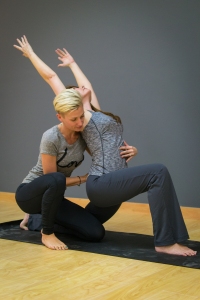 One of the things we often talk about in yoga practice is being present. Being present can mean a lot of different things, but lately I’ve noticed that while I don’t have too much difficulty being present with the each individual pose, I tend to ignore the transition from one pose to the next as if they were dead space. I’m in such a hurry to reach the next pose and be present, and I fail to notice the way I get there. Recently, I spent a couple of classes paying special attention to my body during those transitions. What was moving? What was stable? At what moment was the tension on a certain muscle released? Where did I feel the stretch as I moved into that forward fold?
One of the things we often talk about in yoga practice is being present. Being present can mean a lot of different things, but lately I’ve noticed that while I don’t have too much difficulty being present with the each individual pose, I tend to ignore the transition from one pose to the next as if they were dead space. I’m in such a hurry to reach the next pose and be present, and I fail to notice the way I get there. Recently, I spent a couple of classes paying special attention to my body during those transitions. What was moving? What was stable? At what moment was the tension on a certain muscle released? Where did I feel the stretch as I moved into that forward fold?
